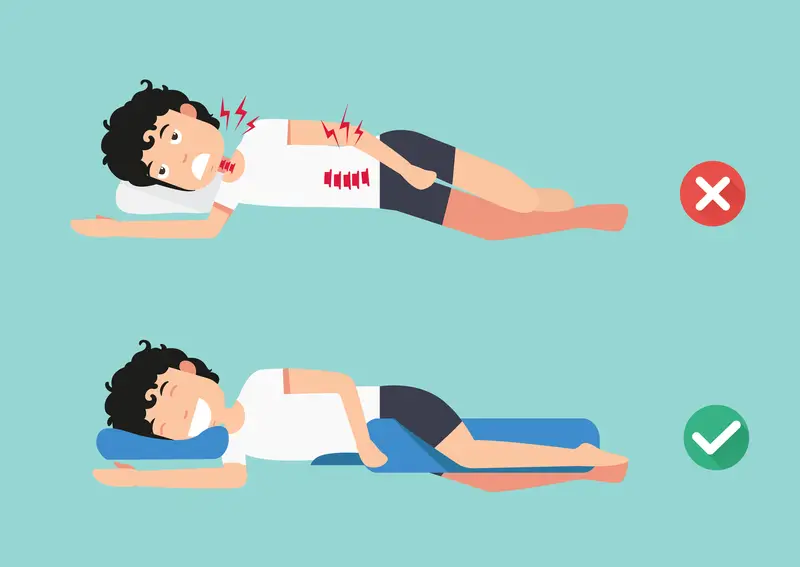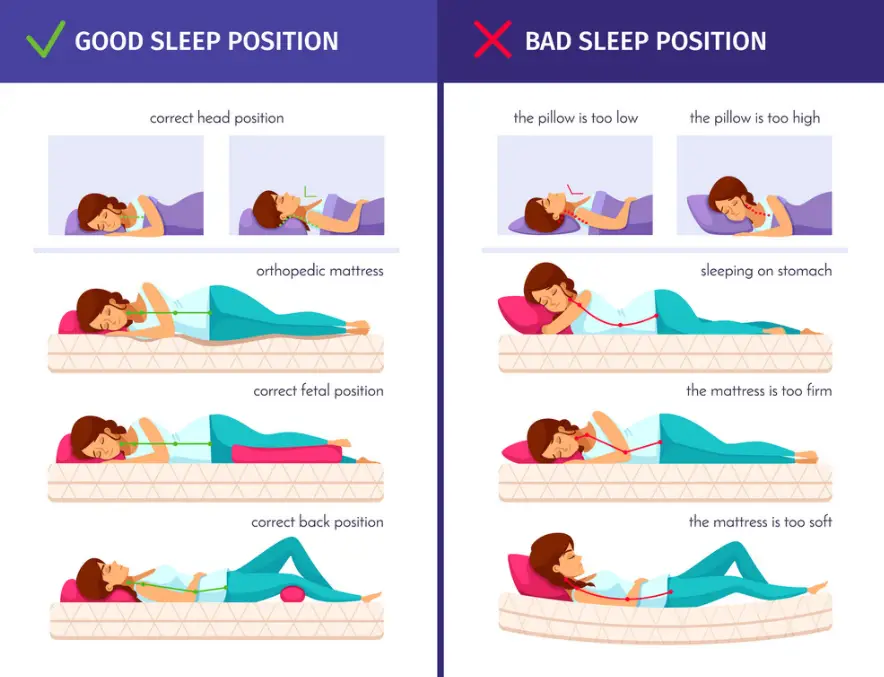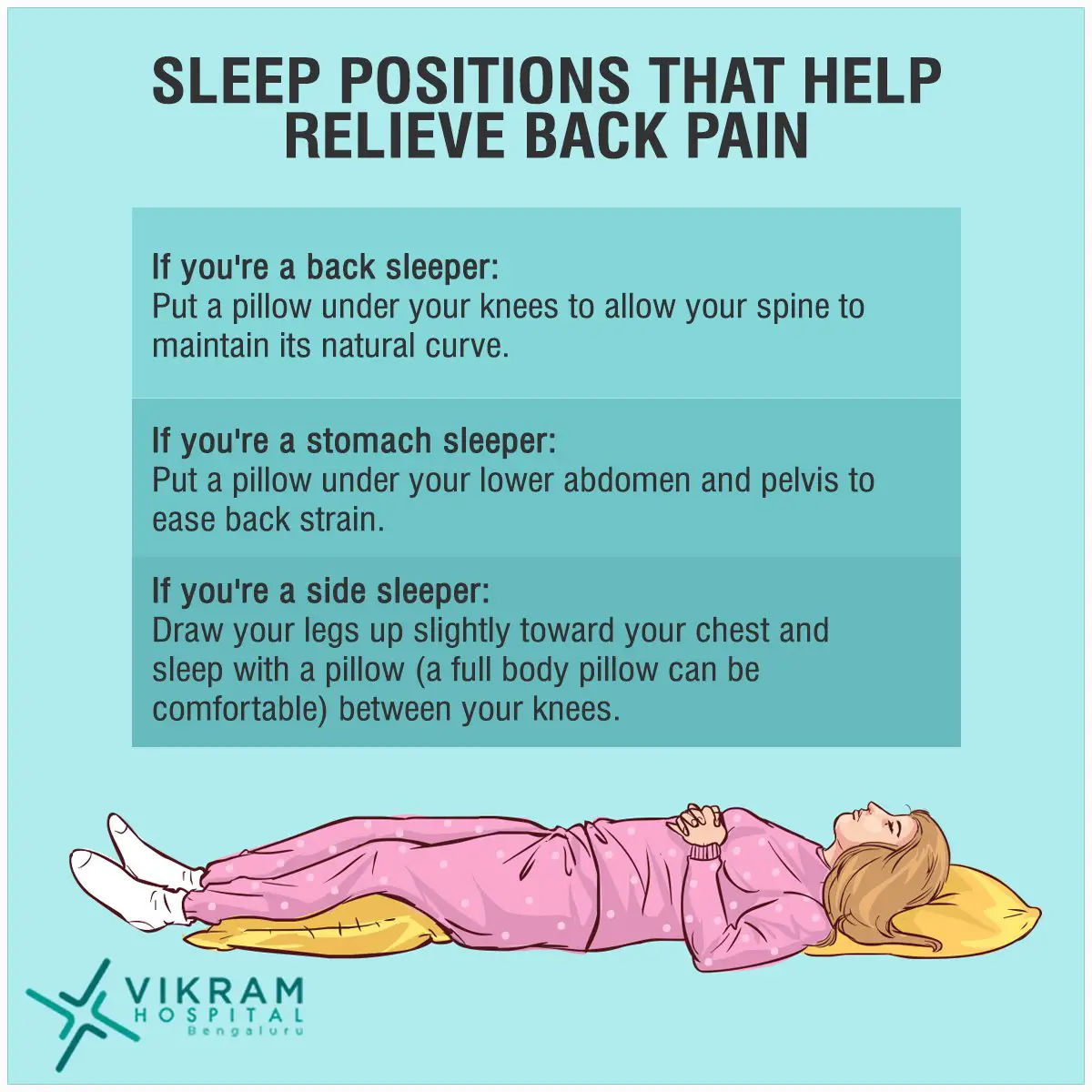Helpful Sleeping Positions To Alleviate Lower Back Pain
On The Back In A Reclined Chair Or Bed
This might help people with lower back pain, particularly those with isthmic spondylolisthesis, a condition in which one spinal vertebra slips over the vertebra right below.
If a person gets significant relief from resting in a reclined chair, it may be worth investing in an adjustable bed that can be positioned in the same way.
Practice Healthy Sleep Posture
Keeping your body aligned as you sleep is one of the most important things you can do to prevent back pain after sleeping. Specifically, your ears, shoulders, and hips should be lined up when you sleep. Sleeping on your back is the healthiest sleeping posture. Back sleeping makes it so your weight is evenly distributed from your head to your toes and relieves added stress on the affected areas. This position keeps your internal organs and spine in alignment for your body’s healthiest function.
Stomach sleeping can lead to more back pain from the additional stress on the curve of your back. Side sleeping can also cause stress on your upper and lower back from the misalignment of your shoulders and hips. If you must sleep on your side due to surgery, pregnancy or other factors, be sure to place a pillow between your knees to allow your hips better alignment.
Recommended Reading: Why Does My Lower Back Hurt In The Morning
Upgrade Your Mattress And Pillows
If your mattress and pillows are old and sagging, theyre likely causing or worsening your lower back pain. We recommend memory foam, latex, or hybrid mattresses for lower back pain because they relieve pressure points and support your spine. Choose a mattress firmness suited for your sleeping position and size for optimal pain relief.
Firm mattresses work best for stomach sleepers and larger individuals because they dont sink very far. Back and combination sleepers typically prefer medium to medium-firm mattresses for their adequate blend of cushioning and support. If youre a side sleeper or lightweight, a medium to medium-soft mattress cradles your wider body parts without causing you to sink or develop pressure points.
If youre not in the market for a new mattress, use a mattress topper. Toppers are available in both soft and firm comfort levels to suit any sleeping position. Search for at least a 2 to 4-inch topper made of latex or memory foam.
With any sleeping position, use a pillow to fill the space between your head and the mattress and keep your head in line with your spine. Too thin or thick of a pillow overextends your neck and leaves it stiff and sore. Opt for memory foam or latex pillows because they closely conform to your head and neck, relieve tension, and provide excellent support.
Pillows For Lower Back Pain

Much like a mattress, a pillow should support the natural curve of your neck and keep it aligned with the chest and lower back while allowing you to get comfortable. You want your alignment to feel natural and not overly propped or flat. Just a tip, pillows also have a shelf life. Most experts recommend replacing the pillow you rest your head on every year or so. But hang onto those old pillows you can use them to support other areas of the body.
Don’t Miss: What Type Of Bed Is Best For Lower Back Pain
Sleep In A Fetal Position
If you have a herniated disc, curl up in a fetal position. When you lie on your side with your knees tucked into your chest, you’ll be able to minimize the bending of your spine and open up your joints simultaneously. If you choose the fetal position, use a pillow to give your head and neck some support.
On The Front With The Face Down
Sleeping on the front is generally unhealthy when a person turns their head to the side, twisting the spine and placing additional stress on the neck, shoulders, and back.
To avoid this, try lying face down. To do so comfortably:
Read Also: Will Midol Help With Back Pain
Do Be Mindful Of How You Get In And Out Of Bed
Jerking yourself out of bed quickly or getting in too fast can exacerbate lower back pain, so make sure youre careful about doing each:
When getting into bed, first sit down near the place where you want to sleep. Then, using your hands as support, bend your knees and slowly lie down on your side. Take care to keep your torso straight.
When getting out of bed, you basically want to do the opposite. Roll onto your side first towards the edge of the bed, bend your knees, then use your arms to help push yourself up and swing your legs over the side. This will help you keep from bending at your waist, which can engage your back.
Tips To Sleep With Back Pain
Sleep is the best remedy for back pain. A good nights rest will make it easier for your body to recover naturally. If youre finding it difficult to sleep because of the pain in your lower back, there are a few things you can try, from changing your sleeping position to optimizing your relaxation before bedtime.
No matter what you do, remember that alignment is key. When you sleep, you should focus on the alignment of your spine. You can do this by making sure your ears, shoulders and hips are lined up. If there are gaps between your body and the bed, use pillows to take away undue pressure. When you turn, keep your core tight. Twisting and turning can wrench your back.
Try These Sleeping Positions
- A warm bath
You May Like: Is Icy Hot Good For Lower Back Pain
How To Sleep With Back Pain: 5 Tips For Relief
Back pain is an acute medical condition that causes physical mobility limitations in everyday life. The sudden onset can last up to six weeks before an individual finds relief. Considered one of the leading causes of musculoskeletal disabilities worldwide, back pain is a common trigger for the problem. More specifically, about 80 percent of adults experience low back pain at some point. While its generally a short-term impairment, if the problem isnt resolved, it can lead to chronic issues. The limitations caused by back pain can affect the completion of everyday tasks and activities. The Mayo Clinic cited radiating and shooting pains, muscle stiffness and strains as well as the need to lay in a reclined position as common signs and symptoms of back pain. The days that you have to roll yourself out of the bed shouldnt be taken lightly. Its important to recognize when something is going on back there and how to troubleshoot the situation.
Shop our most advanced mattress and our best mattress for back pain the Wave Hybrid has hyper targeted support and cooling features to help you ache less and sleep cooler.
Make Sure Your Main Pillow Isnt Causing Pain
Just like there is no one-size-fits-all option for mattresses, the type of pillow a person uses is mostly personal preference as long as it supports the spine in a healthy way. Typically, side sleepers gravitate towards thicker pillows while back sleepers often like thinner pillows.
When picking a pillow, try to make sure it keeps the spine in proper alignment. For back sleepers, that means there should be a straight line from the ear through the shoulders and hips. For side sleepers, the head and neck should remain level with the mid and lower spine.
If you feel like a pillow is propping your head up too much, causing the cervical spine in the neck to lie at an angle, the pillow is too high and may lead to neck and back pain later. Check out our post 21 Of The Best Pillows For Neck Pain for our suggestions on finding the best pillow for reducing pain.
It can be difficult picking out a pillow in the store. Its often hard to tell what it will feel like at home. Consider buying several options and trying them at home, returning the ones that you dont like. Its worth the hassle to find a supportive, comfortable pillow because they make a big difference in overall sleep quality.
Also Check: How To Self Treat Lower Back Pain
Tip #: How You Sleep Is Important
First, make sure youre sleeping in a position that is conducive to maintaining the natural curves of your spine. Specifically, do not sleep on your stomach. Stomach sleeping can cause neck pain and headaches upon waking, and places your spine in an unnatural position.
Try to sleep on either your side or back. If youre a side sleeper, place a pillow between your knees. If you sleep on your back, it may help to place a pillow underneath your knees. Placing the pillow between and underneath your knees gives your spine the best chance of maintaining its natural curves while you sleep.
Best Sleeping Positions For Back Pain

The best sleeping position for lower back pain is widely considered to be on your back. This position distributes the weight along the entire spine. Placing a pillow under your knees will help to maintain the natural curve of the spine.
For those who sleep on their side, placing a firm pillow between the knees helps to maintain the natural alignment of the hips, pelvis and spine. However, if you are a side sleeper, try to alternate sides. This will help to avoid muscle imbalance and perhaps even scoliosis. In addition, side sleeping in a curled-up fetal position may help those with herniated disc pain.
Lying on your stomach is considered the worst sleeping position for back pain. However, if it is difficult to change sleeping positions, place a thin pillow underneath your hips and stomach to improve the alignment of the spine.
Also Check: What Mattress Is Better For Lower Back Pain
Sleeping Positions For Back And Neck Pain
Getting a good nights sleep can be tough with back or neck pain. Its avicious cycle. You need sleep to heal, but your back hurts so you cant sleep,so you cant heal, so your back still hurts and you cant sleep.
The non-restorative sleep that is typical when youre in pain preventsthe relaxation of your muscles and impedes the healing that normally occursduring sleep. During restful sleep, the heart and blood pressure slow, thebrain is able to release the hormones that stimulate tissue growth and repairblood vessels, the body makes more white blood cells and the immune system isboosted.
If sleeping well is that important to healing back pain and neck pain, how do you do it? Heres how to sleep when your back hurts.
Use Good Posture During The Day
Your poor posture practices during the day can derail your efforts to counteract them at night. To avoid back pain during the night, it is essential to practice good posture during the day. Focus on sitting or standing up straight with your shoulders back and your whole body in alignment. That might sound like a simple enough task, but bad posture habits can be tough to break. For that reason, many people turn to a posture brace that can keep you from slouching or hunching forward when your attention is on other things.
Read Also: What Dr Do You See For Back Pain
Sleeping With Lower Back Pain
Lower back pain is a common condition, affecting up to 80% of individuals during their lifetime. Lower back pain can negatively affect your sleep leading to . This is of concern because poor sleep can result in a variety of physiological and psychological effects that can become severe over time and lead to serious health problems including depression, Type II diabetes, obesity, high blood pressure, and coronary artery disease. If youre suffering with lower back pain, chances are youre having difficulty sleeping and are looking for some tips to improve your sleep.
In this article, well outline some of thebest sleeping positions for lower back painand discuss some other tips to improve your sleep.
The Cause Of Back Pain While Sleeping
Your sleep-induced back pain is likely caused by a misalignment of your spine. Most of us dont have perfect posture and our activities throughout the day can begin to tighten muscles in our backs that result in pain while we sleep.
For example, sitting all day can cause the muscles in the hips to tighten, leading to an over-curvature of the spine around the lower back. Or slouching might cause the muscles in the shoulders to tighten, resulting in pain in the upper back.
Certain sleeping positions can exacerbate this tightness. The fetal position that many of us find most comfortable tends to introduce more curvature to the spine and too much straightness to the legs.
Sleeping on the back can cause the lower back to arch. Sleeping on the stomach can push the hips back, leading again to curvature of the lower back. All of this stress on the spine and surrounding muscles can lead to tightness and pain upon waking up or even during the night.
You May Like: How To Relieve Lower Back Pain During Pregnancy
Sleeping On The Back:
Sleeping on your back is the best sleeping posture because it helps distribute weight evenly across the body, keeps the alignment of your internal organs in check, and reduces the amount of pressure points that you might experience from side sleeping. Tip: use a thinner pillow to make sure your head doesnt protrude forward which can contribute to forward neck posture.
Figure Out The Best Sleeping Position For Lower Back Pain For You
If you have back pain, the best sleeping position for lower back pain is on your back. As well discuss, pillows strategically placed underneath the knees can further support the body and minimize arching of the back in this position.
Sleeping on your side isnt ideal, but its much better than sleeping on your stomach, which is considered the worst position for people with back pain. While many people have a default sleeping position, trying to change it could be worth the effort if the position you naturally adopt is causing or worsening pain. Our post The Best Sleeping Position For Lower Back Pain has more suggestions for how to fix your sleeping habits. And, if you cant get away from stomach sleeping, we suggest a few ways to alleviate pain from this position.
Read Also: How To Treat Back Pain
If A New Mattress Isnt In The Cards Make Adjustments To Your Bed
Buying an entirely new mattress may not be economically feasible for you right now. You can make small adjustments now, though, if youre still trying to figure out how to get rid of lower back pain while sleeping.
WebMD.com recommends a few quick solutions. Their major one? If youre looking for a firmer mattress, try adding plywood supports between the mattress and its base. This can increase the firmness of your mattress, quickly and easily.
Sleep On Your Side To Relieve Pain From A Pulled Back Muscle

One of the most common causes of lower back pain is a pulled back muscle, which occurs when a muscle in your lower back is strained or torn as a result of being over-stretched. Symptoms from a pulled back muscle typically resolve within a few days, but the intense pain can make it difficult to fall asleep at night. Worse yet, the longer you lie in the bed, the more deconditioned your body gets and the worse your symptoms may become.
No single sleeping position works for every person with a pulled back muscle, but a good place to start is to test sleeping on your side. When sleeping on your side, try the following:
- Avoid a tight curled-up fetal position , and instead sleep with your body slightly elongated.
- Slip a slim pillow between your knees to support the natural curvature of your spine.
See Mattresses and Sleep Positions for Each Back Pain Diagnosis
- Find a head pillow that holds your head midway between each shoulder. If your pillow is too thin or too thick it can bend your neck at an uncomfortable angle.
You may also benefit from wearing a disposable heat wrap to bed to help alleviate the pain from a pulled back muscle. These wraps deliver muscle-relaxing, low-level heat over the course of several hoursand so they may help you both fall asleep faster and stay asleep longer.
Also Check: Is Epsom Salt Good For Back Pain